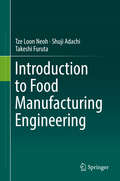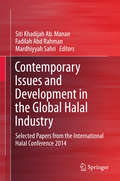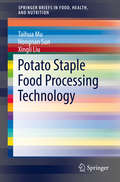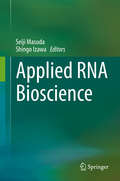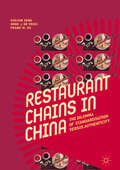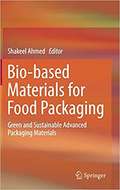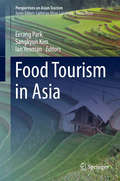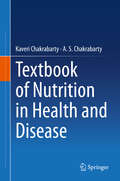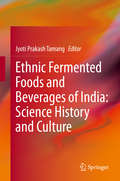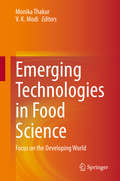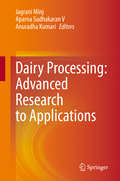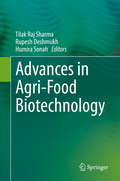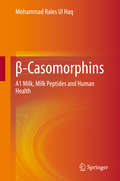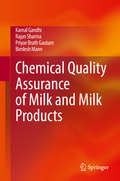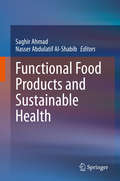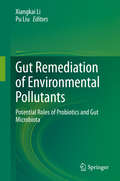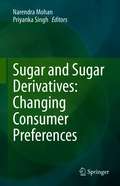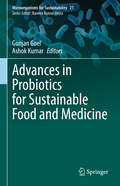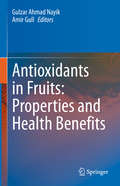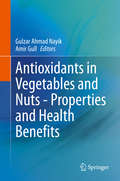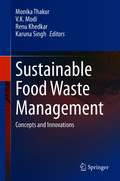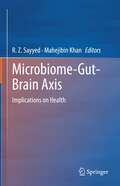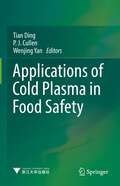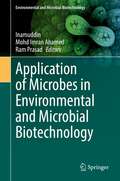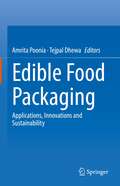- Table View
- List View
Introduction to Food Manufacturing Engineering
by Tze Loon Neoh Shuji Adachi Takeshi FurutaThis book provides basic food engineering knowledge for beginners. The discipline of food processing conforms with actual food manufacturing flows and thus is readily comprehensible, although food engineering has great diversity as the common principles of operations for most food manufacturing processes are covered. This volume therefore endeavors to initially embody food manufacturing flows and pays careful attention to quantitatively detailing and explaining the manufacturing operations involved from an engineering point of view. Because this book is intended to be a very basic introductory text for food engineering, it introduces a variety of foods and food ingredients with which the intended readership is familiar to explain comprehensively the fundamental unit operations through the manufacturing flows. Various real foods and food ingredients are used to explain the principles of food engineering so that students of food science, technology, and engineering courses will be able to better grasp the basic concepts. The book includes many exercises for learning how to draw proper graphs and how to deal with mathematical formulas and numerical values. Readers can learn common principles, which are easily applicable to other fields such as pharmaceuticals and biotechnology, through the many examples that are provided.
Contemporary Issues and Development in the Global Halal Industry: Selected Papers from the International Halal Conference 2014
by Siti Khadijah Ab. Manan Fadilah Abd Rahman Mardhiyyah SahriThis book features more than 50 papers presented at the International Halal Conference 2014, which was held in Istanbul and organised by the Academy of Contemporary Islamic Studies of Universiti Teknologi MARA. It addresses the challenges facing Muslims involved in halal industries in meeting the increasing global demand. The papers cover topics such as halal food, halal pharmaceuticals, halal cosmetics and personal care, halal logistics, halal testing and analysis and ethics in the halal industry. Overall, the volume offers a comprehensive point of view on Islamic principles relating to the halal business, industry, culture, food, safety, finance and other aspects of life. The contributors include experts from various disciplines who apply a variety of scientific research methodologies. They present perspectives that range from the experimental to the philosophical. This volume will appeal to scholars at all levels of qualification and experience who seek a clearer understanding of important issues in the halal industry.
Potato Staple Food Processing Technology
by Taihua Mu Hongnan Sun Xingli LiuThis book introduces readers to volatile compounds of staple foods, while also systematically highlighting the processing technologies of potato staple foods, which will be of great importance in promoting the virtuous circle and structural upgrading of Potato consumption patterns are gradually changing from fresh to processed formulations, (e. g. mashed potatoes, potato chips, etc. ) as a result of fast food habits adopted from developed countries. If the potato can be used to make staple foods, it will not only provide energy, but also nutrition. Though the book is primarily intended for researchers and students in the field of food technology, it will also be of interest to commercial research staff in food technology.
Applied RNA Bioscience
by Seiji Masuda Shingo IzawaThe focus of this book is to introduce up-to-date information on applications and practical use of RNA for agriculture, biotechnology and medicine.<P><P> It provides unique ideas, tools, and methods in detail from a variety of scientific and technical disciplines. RNA science has progressed enormously in recent decades, and vast amounts of information on RNA functions and their regulatory mechanisms are becoming available. Such a progress opened the door to an age of practical application of RNA in many fields including agriculture, plant science, medical science, brewing and fermentation technology, and material production. <P>This book inspires its readership and contributes to not only expansion in application of RNA but also to basic research.
Restaurant Chains in China: The Dilemma Of Standardization Versus Authenticity
by Frank M. Go Henk J. de Vries Guojun ZengThis book explores the paradox of the hospitality industry: customers demand not only personal and innovative tourism products and services, but also cost-effective ones. Enterprises have the option to meet the former demand by offering authentic products and services while the latter could be achieved through standardization. Although it seems ideal to combine both concepts, they seemingly contradict each other leading to suppliers facing an authenticity-standardization paradox. The authors identify, analyze, and provide solutions for this authenticity-standardization paradox based on a series of case studies of restaurants in China. This book will be of interest to scholars, business owners, and consultants.
Bio-based Materials for Food Packaging: Green and Sustainable Advanced Packaging Materials
by Shakeel AhmedThis book provides an overview of the lastest developments in biobased materials and their applications in food packaging. Written by experts in their respective research domain, its thirteen chapters discuss in detail fundamental knowledge on bio based materials. It is intended as a reference book for researchers, students, research scholars, academicians and scientists seeking biobased materials for food packaging applications.
Food Tourism in Asia (Perspectives on Asian Tourism)
by Ian Yeoman Sangkyun Kim Eerang Park<p>This book draws together empirical research across a range of contemporary examples of food tourism phenomenon in Asia to provide a holistic picture of their role and influence. It encompasses case studies from around the pan-Asian region, including China, Japan, South Korea, Thailand, Singapore, Vietnam, and India. <p>The book specifically focuses on and explicitly includes a variety of perspectives of non-Western and Asian research contexts of food tourism by bringing multidisciplinary approaches to food tourism research and wider evidence of food and tourism in Asia.</p>
Textbook of Nutrition in Health and Disease
by Kaveri Chakrabarty A. S. ChakrabartyThis textbook offers a concise, yet comprehensive account of human nutrition, food and nutrition-related health problems, based on the curricula of top universities around the globe. Nutrition is a multidisciplinary science, and as such, the book discusses various aspects of physiology, biochemistry, pathology, immunology, medicine, food science, and other fields related to nutrition, it focuses on the role of nutrition in the maintenance of health. The various chapters explore highly relevant issues, such as, addiction-related health problems, lifestyle-related disorders, social health problems and poor-maintenance of food hygiene and food safety. It also addresses the role of nutritional therapies for mental disorders, and includes an integrated perspective on cognition, oxidative stress and nutritional interventions in aging. Other topics include, the role of gut microbiota on human health, nutraceuticals as therapeutic agents and ketogenic diets. It also highlights malnutrition (protein energy malnutrition, starvation, malabsorption syndrome, eating disorders and overnutrition/obesity) and adipose tissue as an active endocrine organ. Moreover, it examines key concepts concerning the role of vitamins in the citric acid cycle (gluconeogenesis, ketogenesis, oxidative deamination and transamination) and precursors of coenzymes, as well as calorigenic hormones, appetite-stimulating/appetite-inhibiting hormones, anabolic and catabolic hormones affecting protein metabolism, and lipogenetic/lipolytic hormones.
Ethnic Fermented Foods and Beverages of India: Science History and Culture
by Jyoti Prakash TamangThis book provides detailed information on the various ethnic fermented foods and beverages of India. India is home to a diverse food culture comprising fermented and non-fermented ethnic foods and alcoholic beverages. More than 350 different types of familiar, less-familiar and rare ethnic fermented foods and alcoholic beverages are traditionally prepared by the country’s diverse ethnic groups, and include alcoholic, milk, vegetable, bamboo, legume, meat, fish, and cereal based beverages. Most of the Indian ethnic fermented foods are naturally fermented, whereas the majority of the alcoholic beverages have been prepared using dry starter culture and the ‘back-sloping’ method for the past 6,000 years. A broad range of culturable and unculturable microbiomes and mycobiomes are associated with the fermentation and production of ethnic foods and alcoholic drinks in India. The book begins with detailed chapters on various aspects including food habits, dietary culture, and the history, microbiology and health benefits of fermented Indian food and beverages. Subsequent chapters describe unique and region-specific ethnic fermented foods and beverages from all 28 states and 9 union territories. In turn the classification of various ethnic fermented foods and beverages, their traditional methods of preparation, culinary practices and mode of consumption, socio-economy, ethnic values, microbiology, food safety, nutritional value, and process optimization in some foods are discussed in details with original pictures. In closing, the book addresses the medicinal properties of the fermented food products and their health benefits, together with corresponding safety regulations.
Emerging Technologies in Food Science: Focus on the Developing World
by Monika Thakur V. K. ModiThis book provides a comprehensive review of recent innovations in food science that are being used to tackle the challenges of food safety, nutritional security and sustainability. With a major focus on developing nations, like India, the book is divided into four main sections. The first section provides an overview of the food industry, while the second explores food safety in various segments, with an interesting account of street food safety – an important, yet often neglected aspect for safety parameters. The third section, on nutritional security and sustainability, explores various ways of maximizing nutrition and optimizing waste management in the food industry. The book closes with a section on emerging technologies and innovations, which introduces readers to some of the latest technologies in the food industry, including advances in food processing, packaging, nanotechnology, etc. The topics have been divided into 25 different chapters, which offer a diverse blend of perspectives on innovations in the developing world. Ideally suited for students and researchers in the food sciences, the book is also an interesting read for industry experts in Food Science and Technology.
Dairy Processing: Advanced Research to Applications
by Jagrani Minj Aparna Sudhakaran V Anuradha KumariThis book focuses on advanced research and technologies in dairy processing, one of the most important branches of the food industry. It addresses various topics, ranging from the basics of dairy technology to the opportunities and challenges in the industry. Following an introduction to dairy processing, the book takes readers through various aspects of dairy engineering, such as dairy-based peptides, novel milk products and bio-fortification. It also describes the essential role of microorganisms in the industry and ways to detect them, as well as the use of prebiotics, and food safety. Lastly, the book examines the challenges faced, especially in terms of maintaining quality across the supply chain. Covering all significant areas of dairy science and processing, this interesting and informative book is a valuable resource for post-graduate students, research scholars and industry experts.
Advances in Agri-Food Biotechnology
by Rupesh Deshmukh Tilak Raj Sharma Humira SonahThis book presents biotechnological advances and approaches to improving the nutritional value of agri-foods. The respective chapters explore how biotechnology is being used to enhance food production, nutritional quality, food safety and food packaging, and to address postharvest issues. Written and prepared by eminent scientists working in the field of food biotechnology, the book offers authentic, reliable and detailed information on technological advances, fundamental principles, and the applications of recent innovations. Accordingly, it offers a valuable guide for researchers, as well as undergraduate and graduate students in the fields of biotechnology, agriculture and food technology.
β-Casomorphins: A1 Milk, Milk Peptides and Human Health
by Mohammad Raies Ul HaqThis book compiles the latest research on the A1 and A2 forms of cow milk, and attempts to show a correlation between the type of cow milk consumption and reported incidence of certain diseases (type 1 diabetes mellitus, cardiovascular diseases, sudden infant death syndrome and neurological disorders). Cow milk generally contains two types of β-casein, A1 or A2. The book describes the A1/A2 hypothesis, its foundation and the genetics behind it. It discusses the two forms of milk and why one is considered more harmful than the other. Seeking to provide a balanced view of the milk types, the book’s initial chapters highlight the structure, function and physiological activity of β-casomorphins. Subsequent sections describe the health concerns associated with A1 milk, and the various case studies and research surrounding it. In turn, the arguments against the hypothesis put forward by EFSA, American Nutritionists and Truswell are also highlighted. The book does not make any recommendations for dairy consumers; rather, it is a collection of essential data both in favour and against the hypothesis. Further mechanistic studies involving well-designed animal and human trials at the cellular, molecular, biochemical and immunological levels will be needed in order to draw sound conclusions. Overall, the hypothesis is fascinating, and possibly significant. However, verified and authenticated research with reproducible results is needed to make final consumer recommendations. This timely book offers a valuable resource for researchers and students of dairy science, as well as industry experts.
Chemical Quality Assurance of Milk and Milk Products
by Kamal Gandhi Rajan Sharma Priyae Brath Gautam Bimlesh MannThis book discusses quality-related aspects of milk and milk products, covering the various analytical procedures for testing the quality and composition. It also describes the adulteration of milk and milk products and the common as well as advanced techniques used to detect such adulteration. Further, the book examines food laws, guidelines and regulations laid down by FSSAI, CODEX, ISO, IDF and USFDA, and addresses the functioning of a number of international and national organizations, including the WTO, Codex Alimentarius Commission, and BIS. Familiarizing readers with the concepts of QC, TQM, PDCA cycle and related concepts of quality assurance, the book also provides information on other topics that indirectly contribute to the quality of milk and milk products, like the calibration of milk testing equipment, quality of water used in milk processing and the standardization of various chemicals used for testing. This book is a valuable resource for researchers and industry professionals dealing with dairy products.
Functional Food Products and Sustainable Health
by Saghir Ahmad Nasser Abdulatif Al-ShabibThere is a growing global awareness of the link between good diet and health. This fascinating book reviews various functional foods or nutraceuticals and the bio-active compounds they contain in order to identify the role of bioactive compounds such as nisin, micronutrients, and hydrocolloids in the diet in overall human health. It also provides up-to-date information on functional elements like antioxidants, dietary fibres, pre & probiotics, vitamins and mineral-enriched foods in the human diet. Consisting of fifteen chapters, the book offers a systematic review of the key factors in the preparation of functional foods from selected sources, and also describes the processing, preservation and packaging of a range of functional food products. This book is a valuable resource for students and researchers working in the field of food science, food technology, and nutrition, as well as for industry experts.
Gut Remediation of Environmental Pollutants: Potential Roles of Probiotics and Gut Microbiota
by Xiangkai Li Pu LiuThis book focuses on probiotics and gut microbiota, as well as their roles in alleviating the toxicity of various environmental pollutants, presenting the latest research findings and explaining advanced research methods and tools. At the same time, it offers suggestions for future research directions. Further, the book introduces readers to the concept of gut remediation, a potential approach to reducing environmental-pollutant toxicity in vivo, based on modulation of gut microbiota using probiotic supplements. Lastly it provides suggestions for further reading.
Sugar and Sugar Derivatives: Changing Consumer Preferences
by Narendra Mohan Priyanka SinghSugarcane enjoys a prominent position among agro-industrial crops and is commercially grown in 115 tropical and subtropical countries around the world. However, fluctuations in sugar prices have forced the sugarcane industry worldwide to broaden its revenue base by moving from single-commodity manufacturing to a range of value-added products. Utilizing the by-products in an innovative manner to create value-added products is the new course of action for sugar-producing countries. For many years sugarcane was regarded as a single-product crop, i.e., only useful for producing sugar. Its actual potential is now increasingly being recognised by the industry and there is a growing trend toward the manufacturing of allied products from sugarcane. Therefore, the focus is now on the establishment of sugar-agro-industry complexes, processing not just sugar but a range of other products. This book provides a comprehensive overview of sugarcane not only as a source of sweetening agents but also for many other uses, including as a source of bio-energy. It also explores the trend of sugar consumption and suggests practices to curb the consumption of sugar products in order to tackle obesity and reduce public health costs. The book underscores the need to diversify sugarcane and highlights means of doing so, while also addressing various innovations and technologies being developed in connection with sugar, sugar derivatives, and sugar industry by-products for sustainable utilization in the sugar-agro industry. Accordingly, it offers a valuable resource for professionals and R&D units in the sugar industry, and for students of agronomy and related fields.
Advances in Probiotics for Sustainable Food and Medicine (Microorganisms for Sustainability #21)
by Gunjan Goel Ashok KumarThis book focuses on probiotics as sustainable foods and medicines, discussing issues such as screening and identification of probiotics, health claims, and advances in processing technologies, as well as food safety. Based on sound scientific research, the book is a unique reference resource for food scientists interested in development of probiotic based functional foods and their marketing. It will also appeal to those working in the area of regulations regarding the use of and health claims for fermented foods, both locally and globally.
Antioxidants in Fruits: Properties and Health Benefits
by Gulzar Ahmad Nayik Amir GullThis book provides a comprehensive review of the antioxidant value of widely consumed fruits. Each chapter covers the botanical description, nutritional & health properties of these popular fruits. Fruits are one of the most important indicators of dietary quality and offer protective effects against several chronic diseases such as cardiovascular diseases, obesity, and various types of cancer. In order to effectively promote fruit consumption, it is necessary to know and understand the components of fruits. In addition to underscoring the importance of fruit consumption’s effects on human diet, the book addresses the characterization of the chemical compounds that are responsible for the antioxidant proprieties of various fruits.Given its scope, the book will be of interest to graduate and post-graduate students, research scholars, academics, pomologists and agricultural scientists alike. Those working in various fruit processing industries and other horticultural departments will also find the comprehensive information relevant to their work.
Antioxidants in Vegetables and Nuts - Properties and Health Benefits
by Gulzar Ahmad Nayik Amir GullThis book covers the nutritional and nutraceutical profiles of a wide range of popularly consumed vegetables and nuts. The first half of the book focuses on popular vegetables, and describes how higher vegetable consumption reduces the risk of diseases ranging from diabetes to osteoporosis, diseases of the gastrointestinal tract, cardiovascular diseases, autoimmune diseases and cancer. The book also includes an interesting section on the antioxidant potential of mushrooms. In turn, the second half discusses the nutritional value of various nuts. Nuts are nutrient-dense foods with complex matrices rich in unsaturated fats, high-quality protein, fiber, minerals, tocopherols, phytosterols and phenolics. The respective chapters illustrate how the consumption of nuts could ward off chronic diseases like hypertension, cancer, inflammation, oxidative stress, high blood pressure, coronary heart disease etc. In order to effectively promote vegetable and nut consumption, it is necessary to know and understand the nutritional and nutraceutical profiles of vegetables & nuts. Given its scope, the book will be of interest to students, researchers, food scientists, olericulturists, dietitians and agricultural scientists alike. Those working in the vegetable and nut processing industries, horticultural departments and other agricultural departments will also find the comprehensive information relevant to their work.
Sustainable Food Waste Management: Concepts and Innovations
by Monika Thakur V. K. Modi Renu Khedkar Karuna SinghThis book discusses one of the biggest challenges of the food industry, which is waste management. Food industries generate high amounts of waste, both solid and liquid, resulting from the production, processing and consumption of food. Stringent environmental legislators have made the task of waste management more challenging. Through the three sections of this book, the readers are introduced to the different types of wastes generated, utilization of waste through food processing industry and sustainable waste management technologies. The different chapters describe how the biomass and the valuable nutrients from food industry wastes could be used to develop value-added products. The book reiterates that food wastes and their by-products are an excellent source of sugars, minerals, dietary fiber, organic acids, bio active compounds such as polyphenols, carotenoids and phytochemicals etc.This book is an excellent resource for industry experts, researchers and students in the field of food science, food processing and food waste management.
Microbiome-Gut-Brain Axis: Implications on Health
by R. Z. Sayyed Mahejibin KhanThe book highlights the importance of prebiotics, probiotics and synbiotics in the signalling mechanism between gut microbiota and brain, also referred to as the gut-brain axis. A stable gut microbiota is essential for normal gut physiology and overall health, since it assists in proper signalling along the brain–gut axis. The book describes how the cross talks between gut microbiota and brain, not only regulate gastro-intestinal functions but also ensure proper functioning of cognitive behaviour and immunological functions. The various chapters describe probiotic microorganisms that colonize gastrointestinal tract and provide an array of health benefits to the host. It further elaborates about certain non-digestible oligosaccharides (prebiotics) are easily fermented by specialist microbes in the gut, to produce health-promoting metabolites and inhibit the growth of pathogenic bacteria. This book is useful for students, researchers and scientists in the field of microbiology, food science and nutrition. It is also meant for industry experts involved in developing nutraceuticals.
Applications of Cold Plasma in Food Safety
by Tian Ding P. J. Cullen Wenjing YanThis book provides readers with a comprehensive overview of cold plasma technology for tackling the various food-related hazards in a wide range of food sectors. The principles and characteristics of cold plasma generation in gas and its interaction with liquids, as well as its combating modes of action for common hazards (e.g., bacteria, spores, biofilms, fungi, and fungal toxins) are emphasized in this book. It also presents the applications of cold plasma or its hurdles with other techniques to assure the microbiological safety of the key food classifications, including fruits, vegetables, cereals, grains, meat, aquatic products, liquid food products (e.g., juices, milk), nuts, spices, herbs, and food packaging. This book is useful for researchers to grasp the comprehensive understandings of how food safety can be controlled with cold plasma technology. This book also provides adequate information for engineers in food industry for better development and optimization of the plasma-generating systems. Government institutions that are responsible for food safety regulations can understand more knowledge about the intricacies and influencing factors, which should be considered for regulating the applications of cold plasma technology in food.
Application of Microbes in Environmental and Microbial Biotechnology (Environmental and Microbial Biotechnology)
by Inamuddin Ram Prasad Mohd Imran AhamedThis comprehensive edited book on microbial prospective discusses the innovative approaches and investigation strategies, as well as provides a broad spectrum of the cutting-edge research on the processing, properties and technological developments of microbial products and their applications. Microbes finds very important applications in our lives including industries and food processing. They are widely used in the fermentation of beverages, processing of dairy products, production of pharmaceuticals, chemicals, enzymes, proteins and biomaterials; conversion of biomass into fuel, fuel cell technology, health and environmental sectors. Some of these products are produced commercially, while others are potentially valuable in biotechnology. Microorganisms are considered invaluable in research as model organisms. This is a useful compilation for students and researchers in microbiology, biotechnology and chemical industries.
Edible Food Packaging: Applications, Innovations and Sustainability
by Amrita Poonia Tejpal DhewaThis book discusses the various aspects of sustainable packaging edibles in food industry. It is divided into five main parts. The first section of the book addresses details of edible films, various sources, origin, scope and functions. Second section covers different sustainable alternatives such as seed gums, fruits and vegetable peels, sea weeds, fruits wastes, dairy by products & anti-oxidant edible packaging. This book also discusses about methods of improvements of mechanical properties of packaging edibles & their food applications, testing methods, innovations, limitations, challenges and nano edibles. It provides insights about the large quantity of wastes and by-products generated by food processing industries. Disposal of these wastes is a big problem due to their high biochemical oxygen demand (BOD) & chemical oxygen demand (COD) which causes severe problem of pollution to the environment. These wastes contain large amounts of proteins, carbohydrates, lipids, minerals, various bioactive compounds and have eco-friendly packaging potential. The book emphasizes on the fact that recycling these wastes as packaging edibles are sustainable and economical. As a world foreseeing food technology revolution, this book explores the unique topics in food packaging which possesses mammoth commercial applications and environmental potential. Due to its immense scope, this book is highly useful for researchers, food scientists, students and food packaging industry experts.
